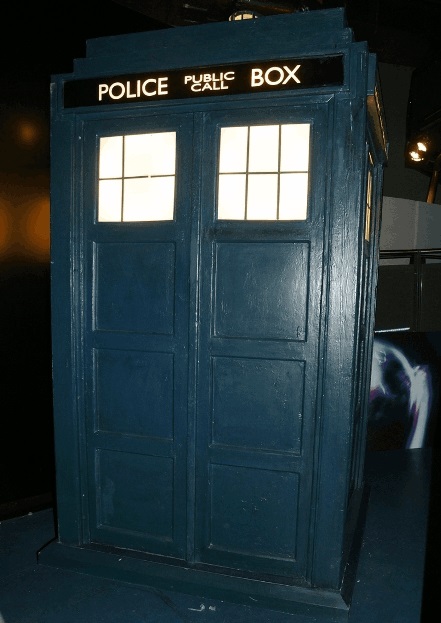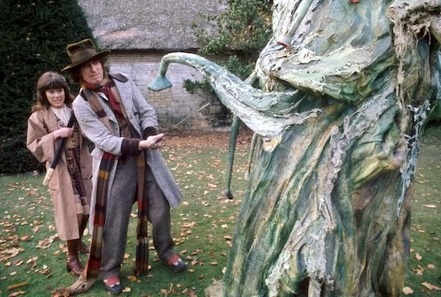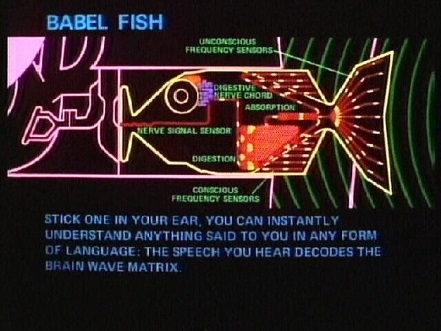
|
The Gadgets When linguists are not used in science fiction to interpret and translate the speech of alien life forms, other devices are utilised. Some are similar to concepts of computer translators while some or are more organic in nature. They are all meant to supposedly remove the need for learning another language, but in reality, they are in place to make it easier on the show writers. Star Trek  Early Universal Translator on Star Trek. As was mentioned before, Star Trek developed a device they refer to simply as the Universal Translator, which is essentially a hand-held device. How it exactly works isn't quite clear. One explanation is that any new language would be translated when a being speaks enough into it for the device to create a translation matrix, after which it would display the results on a screen. Sato is credited with creating a "linguacode" which would actually anticipate (somehow) the language and thus speed up the translation. These were built in to the communication systems of most starships. However, in Star Trek: The Original Series, Captain James Kirk described it in more linguistical terms as well as less technically. Kirk claims that there were certain ideas and concepts that were universally similar to all intelligent life, which is true of languages. The Universal Translator was able to compare brainwave patterns for similar ideas and fill in the proper grammar and vocabulary to make a translation. It didn't stop there. It was also able then to actually replicate the voice of the speaker to speak the translation. This explanation is a bit strange, since it doesn't explain how a translator would work between ships. How does the device figure out which alien or person to scan for the proper brainwave patterns? To make it an instant interpretion as the show depicts, there is no matrix being created, just a super fast telepathic conversion. The oddest part of this, however, is what happens to the voice of the speaker, since we never hear the original language being spoken. Between ships, it might just never transmit the original source, but in face-to-face encounters, there would be some sound. Miraculously, even the lips (if the alien has any) also matches the new speech. In later series of Star Trek, even the pretence of a device was done away with, and it was explained that this functionality was built into the communication badges all personal wore. One oddity in the show is that one race, the Klingons, have their own language which they spoke quite often throughout the series. For some reason, however, this is not translated, and as far as I know, this is never truly explained. Some crew members learn to speak Klingon, yet when they are in the presence of a large number of Klingons on their homeworld, all the Klingon language is either translated or all Klingons are speaking English. Doctor Who The Universal Translator of Star Trek isn't the only one that seems to have some kind of telepathic capabilities. A similar mechanism is used in the Doctor Who universe.  The Tardis can travel anywhere in space and time. It also automatically telepathically translates any language into another. Doctor Who is the longest running science fiction series ever. It is British and first aired in 1963, running for 26 years before being cancelled in 1989. It was then restarted in 2005 and continues on the BBC today. The main character, referred to only as "the Doctor" (the show's title comes from the joke of a person, when meeting the Doctor, asks "Doctor who?"), is a Time Lord from the planet Gallifrey. He is several hundred years old and travels through time and space in a ship that looks like a 1960's British police call box. This ship is called the Tardis, which takes its name from its description "Time And Relevant Dimensions In Space". The Tardis is famous for being bigger on the inside than the outside, due to "transdimensional engineering". The Doctor travels around, seeing the wonders of the universe, and constantly intervening to help when he can. He doesn't travel alone, however, and is often accompanied by one or more companions (most often female and from Earth). Unlike most shows, the main character is an alien himself, so the companions are the way viewers can connect with him. Travelling anywhere in time and space means the show can't simply claim that every one they meet is an Earth colonist (although they do meet plenty of those), and it can't account for when the Doctor and his companions travel back in time or to other countries on Earth. Even if the explanation was that the Doctor has an innate ability to understand all languages, that wouldn't help those that travel with him.  The Doctor and Sarah Jane Smith fighting an alien Krynoid. So for this, they use a similar explanation to the Universal Translator. The Tardis is a semi-sentient entity, which means it and the Doctor can communicate on a more telepathic or empathic (communicating by feelings) level. The Tardis provides the interpretation for the Doctor of those he meets, and when he has companions, they are automatically included into that telepathic circuit. This sometimes help with the storyline. In one episode, companion Sarah Jane Smith has been duplicated, with the fake being sent to fool the Doctor. While talking, the fake asks the Doctor why she can understand everyone around her, and the Doctor then realizes it isn't the real Sarah Jane. The telepathic translation was also used as a joke in an episode with the Doctor and his companion Donna Noble land in Pompeii the day the volcano is going to explode. When the Doctor explains to Donna why she can understand Latin, she asks him what happens if she speaks Latin instead of English, like "veni, vidi, vici". The Doctor admits he doesn't know, so she tries, saying those words to a street vendor. The vendor looks confused, then tells her, slowly and loudly, he doesn't speak Celtic. Same problems here as the Universal Translator: what happens to the original voice and how do the lips keep in sync. In this case, since it is all being done telepathically, that is explained as the brain is just making everyone think they are hearing and seeing what they do. Hitchhiker's Guide to the Galaxy Finally, we come to the most widely recognized science fiction translation device, even if people may not recognize the origins: the Babel Fish. The Hitchhiker's Guide to the Galaxy is a series of books by British author Douglas Adams. It is a comedy about the Earth being destroyed and the last surviving human, Arthur Dent, suddenly finding himself out in a very large and strange universe that no one on Earth ever knew about. He is guided by his alien friend, Ford Prefect, who is a travelling researcher for the electronic book "The Hitchhiker's Guide to the Galaxy". The series was also made into a radio series, a short TV series, and a movie, with all of the stories twisting in different ways from each other.  Almost immediately after the Earth is destroyed and Arthur and Ford manage to survive by hitchhiking onto one of the ships that destroyed it, Ford makes Arthur stick a small fish into his ear. This is the wonderous Babel Fish. The book describes it as "It feeds on brain wave energy, absorbing all unconscious frequencies and then excreting telepathically a matrix formed from the conscious frequencies and nerve signals picked up from the speech centres of the brain, the practical upshot of which is that if you stick one in your ear, you can instantly understand anything said to you in any form of language: the speech you hear decodes the brain wave matrix." This is the most organic of the methods used and perhaps the oddest, for it means the, realistically, most people in the universe are travelling around with small fish in their ears (or whatever listening appendage they may have). After this initial explanation the Babel Fish is essentially never mentioned again. Yet, this has become the most known of devices because of the online translation service, perhaps the oldest, which took its name. Farscape We will mention one more technological replacement which is used in the Australian science fiction TV series Farscape. This series is similar to Hitchhiker's in that it involves a single Earthman, this one being John Crichton, who find himself suddenly in a wild universe of strange beings. He finds his way there by an accidental wormhole while testing a new spacecraft and is unable to return home. John gets picked up by a living spaceship called a Leviathan and named Moya. The crew are escaped fugitives from the militaristic force known as "The Peacekeepers". When John first meets them, there is a lot of chaos because he has never seen beings like them before and they are fearing he is a Peacekeeper. During the confusion, one of the small robots on the ship injects John's foot with "translator microbes", essentially bacteria, which then start automatically interpreting all speech for him. Magical Devices When it comes down to it, most of these devices act more on a principal of magic rather than science. Yet still, many people like to talk about a day when such things will be possible, when the need to learn another language will be completely wiped out by these instruments. I, personally, hope that day never comes, for while it might make communications much easier, it will also steal so much of the uniqueness from our cultures. Maybe we should hold on to speaking alien. PT |
| Speaking with Aliens | ||||||||||||||||||
| Writer: | Erik Zidowecki | |||||||||||||||||
| Images: | ||||||||||||||||||
| ||||||||||||||||||
| Sources: | ||||||||||||||||||
| ||||||||||||||||||
All images are Copyright - CC BY-SA (Creative Commons Share Alike) by their respective owners, except for Petey, which is Public Domain (PD) or unless otherwise noted.
comments powered by Disqus


















